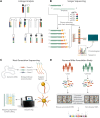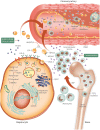Completing the genetic spectrum influencing coronary artery disease: from germline to somatic variation
- PMID: 30789660
- PMCID: PMC6452301
- DOI: 10.1093/cvr/cvz032
Completing the genetic spectrum influencing coronary artery disease: from germline to somatic variation
Abstract
Genetic and environmental factors influence the development of coronary artery disease (CAD). Genetic analyses of families and the population continue to yield important fundamental insights for CAD. For the past four decades, CAD human genetic research focused largely on the study of germline genetic variation in CAD and its risk factors. The first genes associated with CAD were discovered using basic Mendelian principles and pedigree analysis. Mapping of the human genome and advancement in sequencing technology sparked further discovery of novel genetic associations through exome sequencing and genome wide association analysis in increasingly larger populations. While prior work implicated in situ DNA damage as a feature of atherosclerosis, more recently, somatic mutagenesis in and clonal expansion of haematopoietic stem cells was found to influence risk of CAD. Mutations observed for this condition, termed clonal haematopoiesis of indeterminate potential, frequently occur within epigenetic regulator genes (e.g. DNMT3A, TET2, ASXL1, etc.), which are also implicated in leukaemogenesis. Hypercholesterolaemic mice with Tet2 bone marrow deficiency are predisposed to the development of atherosclerosis that may be partly related to inflammatory cytokines. As the genetic basis of CAD expands from the germline to somatic genome, our fundamental understanding of CAD continues to evolve; these new discoveries represent new opportunities for risk prediction and prevention, and a new facet of cardio-oncology.
Keywords: Clonal haematopoiesis of indeterminate potential; Coronary artery disease; Genetics; Somatic mutations.
Published on behalf of the European Society of Cardiology. All rights reserved. © The Author(s) 2019. For permissions, please email: journals.permissions@oup.com.
Figures




References
-
- Murphy SL, Xu J, Kochanek KD, Curtin SC, Arias E.. Deaths: final data for 2015. Natl Vital Stat Rep 2017;66:1–75. - PubMed
-
- Group AW, Timmis A, Townsend N, Gale C, Grobbee R, Maniadakis N, Flather M, Wilkins E, Wright L, Vos R.. European Society of Cardiology: cardiovascular disease statistics 2017. Eur Heart J 2017;39:508–579. - PubMed
-
- Fischer M, Broeckel U, Holmer S, Baessler A, Hengstenberg C, Mayer B, Erdmann J, Klein G, Riegger G, Jacob HJ, Schunkert H.. Distinct heritable patterns of angiographic coronary artery disease in families with myocardial infarction. Circulation 2005;111:855–862. - PubMed
Publication types
MeSH terms
Grants and funding
LinkOut - more resources
Full Text Sources
Medical
Research Materials
Miscellaneous

